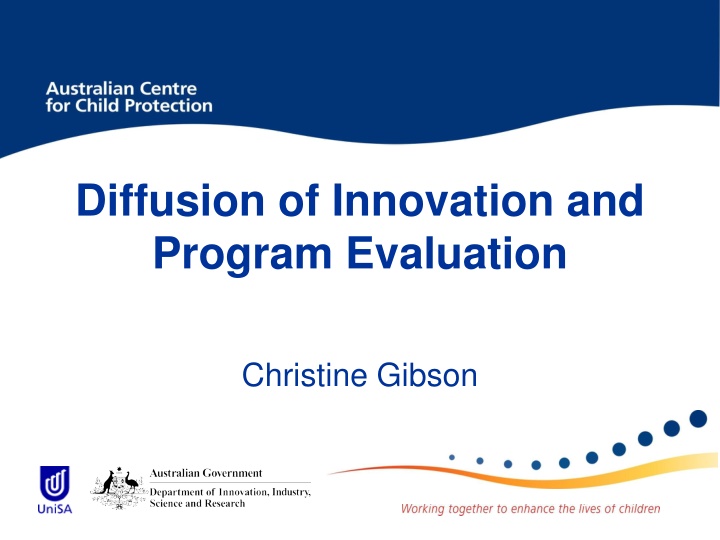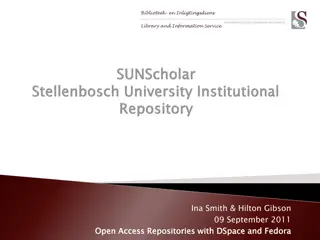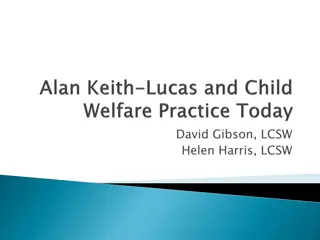
Diffusion of Innovation and Program Evaluation
Explore the intersection of diffusion theory and program evaluation, uncovering patterns and impacts in child and family welfare programs. Discover reasons for adoption and non-adoption, influential factors, and methods to enhance knowledge about innovative programs.
Download Presentation

Please find below an Image/Link to download the presentation.
The content on the website is provided AS IS for your information and personal use only. It may not be sold, licensed, or shared on other websites without obtaining consent from the author. If you encounter any issues during the download, it is possible that the publisher has removed the file from their server.
You are allowed to download the files provided on this website for personal or commercial use, subject to the condition that they are used lawfully. All files are the property of their respective owners.
The content on the website is provided AS IS for your information and personal use only. It may not be sold, licensed, or shared on other websites without obtaining consent from the author.
E N D
Presentation Transcript
Diffusion of Innovation and Program Evaluation Christine Gibson
Australasian Evaluation Society 2011 International Conference Diffusion of innovation and program evaluation Understanding of diffusion theory can help evaluators uncover patterns and impacts that might otherwise be overlooked Ashley (2009)
Diffusion of Innovation and Program Evaluation UnitingCare Burnside: promising child and family welfare programs (the innovations) NEWPIN (imported) Intensive Family-Based Service (imported), Men in Families, Family Group Conferencing (imported), Family Learning Centre, New Steps Family Home Visiting (imported) Moving Forward
Case studies, archival material, semi-structured interviews, a survey and in-depth interviews
Main reasons for adoption: Met with organisation s mission or vision Seemed promising Funds available or not too expensive Perceived benefits to families Perceived benefits to children
Influential factors: Evidence of effectiveness Adaptability Communication Values Resources
Reasons for non-adoption The problem is that you have to expend the resources to train volunteers and have less guarantee of a stable workforce. The supervision and training costs are high and the service provides a lower level of expertise. Respondent who had heard of New Steps Home Visiting Program
Knowledge about program conference presentations staff promoting programs in new workplaces training where programs were discussed conducting literature reviews direct experience from involvement with or referral to the programs membership of networks in which the programs were discussed and osmosis
Origin of the program Our organisation is continually looking to support new program models from overseas which have been going for a few years and which have already built an evidence base and a reputation, self-fund them for the first five years and build our own evidence in our own region, then seek external funding to sustain the programs. From our experience government funders are more likely to fund imported programs and are more likely to take their goodness on face value because they are from the UK or the US. We know we are less likely to win funding for home grown programs. Respondent who had heard about NEWPIN
Roles of champions A staff member who used to work at Burnside brought the idea for the play, sing and music group to this organisation. Based on her practice wisdom, it was believed that the group could have some therapeutic benefits that might transfer into people s lives. Respondent who was using something like the Family Learning Centre
Relative advantage We have an advisory committee and a board. The obstacles with the intensive service are that a lot more money, staff and resources are put into clients than in the traditional refuge models. The stress on workers is high, particularly when there are more outreach clients. It takes a lot to argue for a service that costs more than the previous three that the government cut. Respondent who had something similar to the Intensive Family-Based Service
We were instructed to use it as a process that is embedded in legislation. However before Family Group Meetings were in use, our workers would get the families here and tell them before court what they have to do like it or lump it. With Family Group Meetings this has shifted. Many workers have learned to let go of the power because they have seen that it is quite positive to family change and ownership of decisions. In fact, workers who have had more difficulty with Family Group Meetings are those who are more authoritarian and who have traditionally used their own power in practice. My observations are that those workers have had the least positive outcomes. Respondent who was using something like Family Group Conferencing
Reasons for non-adoption The government s use of it without the family-only time means that families are not given responsibility and power to be truly engaged in making their decisions and owning them. You know when people are in crisis, the people they can speak to happens privately. The model needs to reflect this. They also don t always bring in Indigenous workers, so that is an issue too. Respondent who had heard of Family Group Conferencing
Program sustainability All the way through our program, the government has been supportive of our work. We have a high level of credibility in the service sector. We are the only service of this type in [this state] and we are in high demand. However, we put a lot of effort into nurturing our relationship with [the state department responsible for funding] Respondent who had something similar to Intensive Family-Based Service
Methodological challenges difficult to delineate aspects of change organisational boundaries generalisability
Who? The adopter (potential or actual) What? The nature of the innovation Why? avenues, networks and media Societal factors Communication content,
Diffusion of Innovation and Program Evaluation Does the innovation have advantages over the current way of doing things? Advantage: Compatibility: Is it a good fit with the values of the organisation? Resources: Are the available resources realistic? Knowledge: Are the right people involved? Is training needed? Feedback: How will the results of the evaluation be communicated to those within and those outside the organisation?
References Rogers, E. (2003) Diffusion of innovations (5th ed.). New York: Free Press. Ashley, S. R. (2009) Innovation Diffusion: Implications for Evaluation. In J.M Ottoson & P. Hawe (eds.) Knowledge utilization, diffusion, implementation, transfer, and translation: Implications for evaluation. New Directions for Evaluation, 124, 35-45 K. Lewig, F. Arney, M. Salveron, H. McLaren, C. Gibson and D. Scott. (2010) Spreading promising ideas and innovations in child and family services. InF.Arney & D. Scott (eds.) Working With Vulnerable Families: A Partnership Approach. Melbourne: Cambridge University Press. www.unisa.edu.au/childprotection
Christine Gibson Community Research Liaison Australian Centre for Child Protection University of South Australia (08) 8302 2981 Christine.gibson@unisa.edu.au www.unisa.edu.au/childprotection Image source: Istockphoto

















